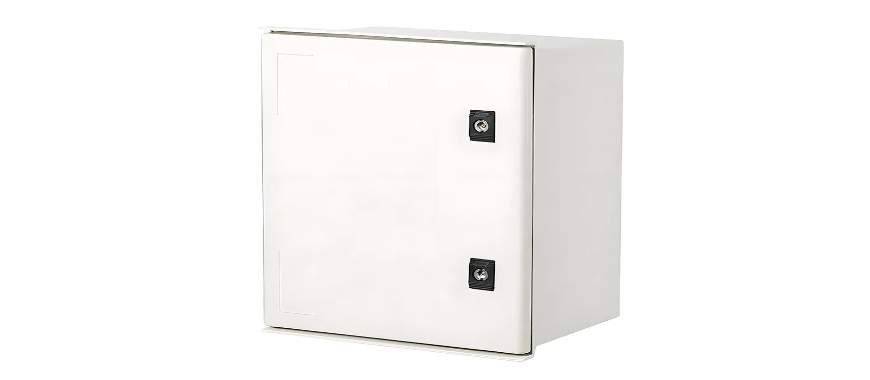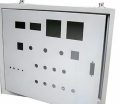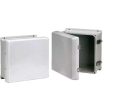
A reinforced fiberglass box is a durable enclosure composed of fiberglass-reinforced plastic. It consists of glass fibers embedded within a polymer matrix, offering exceptional strength and lightweight properties. These boxes are primarily designed to protect sensitive equipment from environmental hazards and mechanical damage. The reinforced fiberglass box is highly valued for its resistance to corrosion, weather exposure, and electrical interference. Its non-conductive nature makes it suitable for various electrical installations, where a fiberglass box knockout provides convenient access for wiring. These boxes are commonly used in industries such as telecommunications, construction, and manufacturing, ensuring safety and functionality in outdoor or harsh environments. Across different sectors, the reinforced fiberglass box serves multiple purposes, including electrical housing, secure storage solutions, and protection for mechanical components in corrosive settings.
Reinforced Fiberglass Box Price and Cost Considerations
When selecting a reinforced fiberglass box, understanding the factors influencing its price is essential. These boxes are often chosen for their durability, strength, and resistance to environmental damage. However, their price and total cost may vary based on multiple elements. Additionally, purchasing in bulk can impact the overall investment, leading to long-term savings.
Factors Affecting Reinforced Fiberglass Box Price
Several variables affect the pricing of reinforced fiberglass boxes, influencing both individual and bulk purchases. Below are some key factors:
- Material Composition and Thickness
- Boxes with higher glass fiber content provide increased strength, contributing to a higher price.
- Thicker enclosures offer enhanced durability but require more material, increasing production costs.
- Manufacturing Processes
- Different manufacturing methods, such as compression molding or resin transfer molding, impact pricing.
- Labor-intensive processes and customization options can add to the overall price.
- Environmental and Safety Features
- Boxes designed for extreme environments with additional UV protection or flame resistance may cost more.
- Enclosures with certifications for safety standards and compliance also command higher prices.
Understanding the Reinforced Fiberglass Box Cost for Bulk Purchases
Purchasing reinforced fiberglass boxes in bulk offers several financial benefits. Organizations that require multiple units for industrial or commercial use can often negotiate reduced rates with suppliers. Here are some considerations related to bulk purchasing:
- Economies of Scale
- Larger orders typically reduce the per-unit price, allowing companies to save on large-scale installations.
- Manufacturing in batches reduces production time, leading to lower operational costs.
- Storage and Logistics Costs
- Bulk purchases may require more space, increasing storage costs. Efficient planning helps minimize logistics expenses.
- Some suppliers offer free shipping or discounts for bulk orders, further lowering the overall cost.
- Long-Term Value
- Bulk purchasing minimizes the need for frequent reorders, saving time and administrative costs.
- Having extra reinforced fiberglass boxes in stock ensures quick replacements and reduces downtime for essential equipment.
By carefully evaluating these factors, businesses can plan cost-effective purchases while ensuring they receive high-quality reinforced fiberglass boxes suited to their operational needs.
Why Choose GRP Box Profile Roofing Sheets
Reinforced Fiberglass Box for Sale – How to Choose the Best Option
Selecting the right reinforced fiberglass box is essential for ensuring proper protection, durability, and efficiency in various applications. With several features and specifications available, identifying the ideal box involves evaluating key characteristics. For electrical installations, fiberglass boxes low voltage offer distinct advantages, particularly in providing secure containment for sensitive components. Large fiberglass enclosures, in particular, offer specialized benefits, requiring thoughtful comparison to meet specific needs.
Essential Features to Look for in Fiberglass Enclosure Boxes
When purchasing a reinforced fiberglass box, these features should be considered to match operational requirements:
- Weather Resistance
- Boxes with UV protection prevent degradation from prolonged sunlight exposure.
- Weatherproof designs ensure the box remains functional under heavy rain or extreme temperatures.
- Impact Resistance and Durability
- Fiberglass enclosures are resistant to mechanical damage, providing reliable protection for sensitive equipment.
- Higher impact ratings help maintain box integrity during accidental drops or environmental stress.
- Corrosion Resistance
- These boxes are highly resistant to rust, making them ideal for coastal or chemical-prone environments.
- Fiberglass materials outperform metal in environments where exposure to moisture is frequent.
- Ease of Installation and Maintenance
- Lightweight construction simplifies installation in hard-to-reach areas.
- Minimal maintenance requirements reduce long-term operational costs.
Comparing Large Fiberglass Electrical Enclosures
Large fiberglass electrical enclosures are common for industrial applications, housing electrical components safely. Below is a comparison of essential attributes:
| Attribute | Standard Fiberglass Enclosure | Reinforced Fiberglass Box |
|---|---|---|
| Impact Resistance | Moderate | High |
| Weatherproof Design | Basic | Advanced UV and rainproof |
| Ease of Installation | Moderate | Easy, due to lightweight design |
| Corrosion Resistance | High | Very High |
| Common Applications | Indoor installations | Outdoor, industrial, and electrical setups |
Selecting the best reinforced fiberglass box requires balancing factors such as durability, weather resistance, and ease of use. A comprehensive understanding of the differences between standard enclosures and reinforced versions ensures that the right solution is chosen for specific industrial needs.
Reinforced Fiberglass Box Manufacturers and Product Standards
Manufacturers play a critical role in developing high-quality reinforced fiberglass box solutions for various industries. To ensure these products meet market demands, they must adhere to efficient manufacturing processes and maintain strict compliance with industry standards. Reliable manufacturing and certification practices guarantee the boxes’ durability, safety, and effectiveness in real-world applications.
Key Manufacturing Processes for Fiberglass Enclosure Boxes
The production of reinforced fiberglass boxes involves advanced techniques to combine fiberglass with polymers, ensuring the enclosure is both durable and lightweight. Below are some essential manufacturing methods:
- Resin Transfer Molding (RTM)
- Resin and fiberglass are placed into a mold where the polymer matrix solidifies.
- This process provides high precision, ensuring consistent thickness and improved structural integrity.
- Compression Molding
- Fiberglass and resin are compressed under heat to form the enclosure’s shape.
- This method creates highly durable enclosures with complex shapes and consistent finishes.
- Pultrusion
- Continuous fiberglass strands are pulled through resin baths and molds to create strong, rigid shapes.
- This method is ideal for producing enclosures with long, uniform cross-sections, enhancing mechanical strength.
- Hand Lay-Up Process
- Layers of fiberglass mat are manually laid into molds and saturated with resin.
- Although labor-intensive, this process allows for customization and is used for specialized enclosures.
Industry Standards and Certifications
Manufacturers of reinforced fiberglass boxes must meet specific certifications and standards to ensure their products meet regulatory and safety requirements. Below are key standards often followed in the industry:
- NEMA (National Electrical Manufacturers Association)
- NEMA ratings ensure enclosures provide adequate protection against environmental hazards like dust, moisture, and corrosion.
- NEMA-rated reinforced fiberglass boxes are commonly used in electrical installations and industrial environments.
- IP (Ingress Protection) Standards
- IP ratings assess the degree of protection provided against solid objects and water ingress.
- High IP ratings ensure reinforced fiberglass boxes are suitable for outdoor and industrial applications.
- UL (Underwriters Laboratories) Certification
- This certification verifies that enclosures meet stringent safety and quality standards.
- UL-listed reinforced fiberglass boxes are preferred for environments where safety compliance is critical.
Reinforced Fiberglass Ground Box – Specialized Applications and Benefits
The reinforced fiberglass ground box is a specialized type of enclosure designed to be installed underground. It offers robust structural benefits and ensures long-term reliability in demanding conditions.
Structural Benefits of Reinforced Fiberglass Ground Box
- High Load-Bearing Capacity
- The box can support heavy loads, making it ideal for installation beneath pedestrian or vehicle paths.
- Reinforced fiberglass construction ensures durability under stress from traffic or environmental shifts.
- Corrosion Resistance
- Unlike metal enclosures, the fiberglass structure resists rust, even when exposed to moisture or chemicals underground.
- This resistance extends the service life of the enclosure and reduces the need for replacements.
- Electrical Insulation
- Fiberglass provides natural insulation, preventing electrical hazards when housing power systems.
- This property ensures safe use for buried electrical components and communication systems.
Installation and Maintenance Insights
- Lightweight Design for Easy Installation
- The reinforced fiberglass ground box is lightweight, reducing labor costs and installation time.
- It can be easily transported and installed without heavy machinery.
- Minimal Maintenance Requirements
- Fiberglass enclosures require minimal upkeep, reducing long-term operational expenses.
- Inspections are infrequent, as the box resists both environmental degradation and mechanical damage.
- Applications Across Various Sectors
- Commonly used in telecommunications, electrical grids, and utility management.
- The ground box offers protection for buried connections, including cables, pipelines, and network infrastructure.
By understanding the structural advantages and installation methods, businesses can make informed decisions when selecting reinforced fiberglass ground boxes for specific applications. These boxes provide a reliable solution for protecting underground systems, ensuring safety and longevity.
Affordable GRP Storage Box for Long-Term Solutions
Applications of Large Reinforced Fiberglass Box
Large reinforced fiberglass box enclosures are essential for protecting electrical equipment and industrial components in various environments. Their unique properties make them highly effective for applications that require durability, safety, and environmental resistance. These enclosures offer distinct advantages in both electrical and industrial settings, ensuring secure operations over long periods.
Advantages for Electrical and Industrial Applications
Large reinforced fiberglass boxes are extensively used to house electrical equipment and protect industrial components. Below are some key benefits that make these enclosures a preferred choice:
- Electrical Insulation
- Fiberglass is non-conductive, reducing the risk of electrical hazards or short circuits.
- These enclosures are ideal for housing sensitive electronic systems and power distribution units.
- Fire Resistance
- Fiberglass materials resist high temperatures, providing fire protection for critical equipment.
- This makes them suitable for industrial environments with elevated fire risks.
- Lightweight and Easy to Install
- Despite their size, large reinforced fiberglass boxes are lightweight, simplifying installation.
- The reduced weight minimizes transportation and labor costs, particularly for elevated installations.
- Corrosion Resistance in Industrial Settings
- Fiberglass enclosures are resistant to rust and chemical corrosion, unlike metal counterparts.
- They perform well in chemical plants, coastal regions, or environments with constant moisture exposure.
- Customization Options for Industrial Needs
- These enclosures can be customized with cable entries, ventilation, and security locks.
- Their flexibility ensures compatibility with various industrial and electrical setups.
Environmental Resistance and Durability
Large reinforced fiberglass boxes are designed to withstand harsh environmental conditions. Their robust construction makes them an excellent choice for outdoor and industrial use where environmental challenges are common.
- Weatherproof Design for Outdoor Use
- These enclosures resist rain, wind, and dust, making them ideal for outdoor installations.
- UV-resistant coatings prevent degradation from long-term exposure to sunlight.
- Performance in Extreme Temperatures
- Fiberglass materials maintain their integrity in both extremely hot and cold climates.
- This ensures reliable performance in industrial zones with fluctuating temperatures.
- Impact and Vibration Resistance
- The fiberglass structure absorbs shocks and vibrations, protecting internal components from damage.
- This feature is crucial for enclosures installed in high-traffic areas or industrial sites with heavy machinery.
- Minimal Maintenance Requirements
- These enclosures require minimal upkeep due to their resistance to rust, corrosion, and weathering.
- Reduced maintenance lowers long-term operational costs, benefiting industries with multiple installations.
Practical Applications of Large Reinforced Fiberglass Boxes
- Telecommunication Networks
- Used to house communication equipment and protect cabling systems from environmental damage.
- Ensures uninterrupted service in remote locations and urban installations.
- Electrical Substations
- Installed to protect transformers, circuit breakers, and other essential electrical components.
- Prevents equipment malfunctions caused by moisture or dust accumulation.
- Renewable Energy Systems
- Deployed in solar farms and wind turbine installations to protect electrical inverters and batteries.
- Their weatherproof properties make them suitable for outdoor energy systems.
- Utility Infrastructure
- Large reinforced fiberglass boxes are used for underground utilities, including water and gas meters.
- Their corrosion resistance ensures a longer service life in moisture-prone environments.
Large reinforced fiberglass boxes offer essential advantages for various industries, from telecommunication to renewable energy. Their environmental durability and practical benefits provide long-term security for critical systems, making them a reliable solution for modern infrastructure needs.
Best Poly Fiberglass Box for Harsh Environments
The Value of Investing in a Reinforced Fiberglass Box
Investing in a reinforced fiberglass box provides businesses and industries with a practical solution for protecting sensitive equipment. These enclosures deliver exceptional performance by combining durability, environmental resistance, and ease of installation. As industries continue to seek reliable, long-lasting solutions, fiberglass boxes emerge as essential components for electrical, industrial, and commercial operations.
Long-Term Benefits for Industrial and Commercial Use
- Extended Service Life
- Reinforced fiberglass boxes are highly durable, reducing the need for frequent replacements.
- Their corrosion-resistant properties ensure they remain intact in environments prone to moisture and chemical exposure.
- Reduced Maintenance Effort
- Minimal maintenance requirements lower operational expenses over time.
- Inspections are infrequent, as fiberglass resists rust and environmental degradation.
- Enhanced Equipment Protection
- These enclosures safeguard electrical systems and industrial equipment from weather, impact, and electrical hazards.
- Fiberglass’s insulating properties offer an extra layer of safety for electrical components.
- Improved Installation Flexibility
- Lightweight construction allows for easy transportation and installation without heavy machinery.
- This flexibility benefits industries with complex installations, saving labor time and costs.
Summary of Cost-Effectiveness and Practical Applications
Choosing a reinforced fiberglass box offers significant long-term value. While the initial cost may be higher than some metal alternatives, the reduced maintenance and extended lifespan provide considerable savings.
- Lower Total Ownership Costs
- The durable design reduces long-term expenses related to repairs and replacements.
- Fiberglass’s weather and corrosion resistance ensure fewer disruptions and lower downtime.
- Versatile Applications
- These enclosures are used in electrical grids, utility management, renewable energy systems, and telecommunications networks.
- Their practical design supports both outdoor installations and underground systems.
- Environmental Sustainability
- Fiberglass enclosures last longer, decreasing material waste associated with frequent replacements.
- Their resistance to harsh conditions ensures stable performance across multiple industries.
Investing in a reinforced fiberglass box ensures long-term benefits for industrial and commercial users, providing a cost-effective, reliable solution that meets various operational needs. The combination of durability, flexibility, and low maintenance solidifies fiberglass as a preferred material for protecting valuable equipment in both routine and challenging environments.
FAQs about Reinforced Fiberglass Box
Yes, fiberglass can be reinforced to improve its strength and durability. This process involves embedding glass fibers into a polymer matrix, creating a composite material known for its enhanced mechanical properties. Reinforced fiberglass maintains a lightweight structure while offering greater resistance to impact and environmental stress. It becomes stronger, making it suitable for applications that require high load-bearing capacity, such as industrial enclosures and vehicle components. Additionally, reinforcement improves the material’s resistance to corrosion and extreme temperatures, extending its lifespan. Industries like construction, utilities, and aerospace rely on reinforced fiberglass for projects where both flexibility and strength are essential.
Fiberglass-reinforced plastic (FRP) is considered highly effective due to its durability, corrosion resistance, and versatility. FRP products, including reinforced fiberglass boxes, excel in environments that expose materials to moisture, chemicals, or extreme temperatures. Their lightweight nature simplifies installation, while their strength ensures protection from impact and mechanical damage. Furthermore, FRP provides excellent electrical insulation, reducing safety risks when used in electrical installations. Maintenance needs are minimal, leading to long-term cost savings. FRP materials also contribute to sustainability, as their durability reduces the frequency of replacements. For these reasons, FRP is widely used in industries such as transportation, utilities, and construction.
Fiberglass-reinforced panels (FRP) serve diverse purposes across many industries. These panels are used in areas where durability, moisture resistance, and hygienic surfaces are required. They are commonly installed in laboratories, food processing facilities, and commercial kitchens, where easy-to-clean walls and ceilings are essential. Industrial warehouses also benefit from FRP panels, as they provide impact-resistant surfaces that withstand heavy use. FRP panels often cover the exteriors of buildings, offering protection from weather and UV exposure. In addition, these panels are applied in utility sectors to insulate and protect electrical systems. Their reliability makes them suitable for both indoor and outdoor use, ensuring long-term performance with minimal maintenance.
A fiberglass electrical box offers several advantages, especially in environments where traditional metal enclosures may not perform well. These boxes are lightweight, which simplifies installation and reduces labor costs. Unlike metal enclosures, fiberglass electrical boxes are corrosion-resistant, making them ideal for humid, coastal, or chemically harsh environments. They also provide superior electrical insulation, which lowers the risk of electrical faults and short circuits. Additionally, fiberglass electrical boxes are designed to withstand extreme weather conditions, ensuring the safety of internal components. Their low maintenance requirements make them a cost-effective solution for industrial facilities, utility management, and renewable energy installations. As a result, fiberglass electrical boxes have become a preferred choice for both commercial and residential applications.

As the editor of GangLong Fiberglass, I have years of experience and in-depth research, focusing on cable tray products, fiberglass solutions, and grille systems. I incorporate years of industry insights and practical experience into every content, committed to promoting the progress of the industry. At GangLong Fiberglass, my commitment is reflected in every product, from innovative cable trays to durable fiberglass solutions and sturdy grille systems. As an authoritative voice in the industry, my goal is to provide valuable information to professionals and businesses and promote forward-looking solutions.


